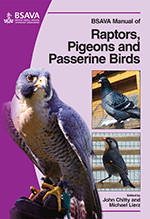
Full text loading...

For a veterinary surgeon the treatment of the single pet passerine bird raises many fascinating challenges, especially with diagnosis and therapy. Although the treatment of these birds is unlikely to have a serious impact on a practice’s time or economics, it is important to appreciate the emotional value of these birds to their owners. This chapter discusses clinical history and examination; stabilization of a sick passerine bird; diagnostic procedures; therapeutics; common surgical procedures; diseases of the respiratory tract; and nutritional diseases.
Passerine birds: approach to the sick individual, Page 1 of 1
< Previous page | Next page > /docserver/preview/fulltext/10.22233/9781910443101/9781910443101.34-1.gif

Full text loading...





